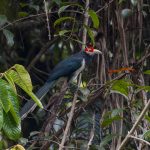
Mentioning New Jersey often raises a snicker or a run down of all the drama and negative stereotypes that swirl around the Garden State, most of which are typified by the MTV hit show, “Jersey Shore.” While certain New Jersey decisions may be dubious, their state bird, the American Goldfinch, is a beautiful choice.
The legislature named the goldfinch the state bird in 1935, sharing the designation with Washington and Iowa. American Goldfinches are found in much of the United States all year round, spreading their range to Canada in the summer, and into the southern United States and Mexico in the winter. Now, more than ever, they are an iconic piece of the birding landscape, for David Sibley’s “The Sibley Field Guide to to Birds of Eastern North America,” features none other than an American Goldfinch on the cover!
Though their natural habitat includes fields and floodplains, they can also be found in agricultural areas, orchards, along the road, and at backyard feeders. They are a brilliant yellow during breeding season and a faded gold in the winter, but even in their duller plumage can still can pop against a snowy winter scene.
Unlike many other songbirds, these goldfinches subsist entirely on a vegetarian, seed-based diet. In fact, it is their reliance on seeds that actually protects them against Brown-headed Cowbirds, the famous parasitic nesters. The cowbirds will try to lay their eggs in a goldfinch nest, but once hatched the young only survive a few days. Like the adults, the goldfinch chicks also eat only seeds, and the cowbird babies cannot survive long on that diet.
The populations of American Goldfinch are doing well throughout their range. Since surveys began in 1966, their populations have remained stable, with 42 million birds in their breeding population, 71% of which spend at least part of their year in the United States.













You’d think that after enough years, the cowbirds would have learned not to bother with goldfinches.
Since female cowbirds don’t hang around to see how good a job the foster parents do, I don’t think there is any opportunity for that kind of learning.